
The Lincoln, sometimes called the Lincoln Longwool, is a breed of sheep from England. The Lincoln is the largest British sheep, developed specifically to produce the heaviest, longest and most lustrous fleece of any breed in the world. Great numbers were exported to many countries to improve the size and wool quality of their native breeds. The versatile fleece is in great demand for spinning, weaving and many other crafts.

The Cotswold is a British breed of domestic sheep. It originates in, and is named for, the Cotswold hills of the southern midlands of England. It is a large long-woollen sheep, and is kept as a dual-purpose breed, providing both meat and wool.

The Border Leicester is a British breed of sheep. It is a polled, long-wool sheep and is considered a dual-purpose breed as it is reared both for meat and for wool. It is known for its distinctive upright ears. The sheep are large but docile. They have been exported to other sheep-producing regions, including Australia and the United States.

The Jacob is a British breed of domestic sheep. It combines two characteristics unusual in sheep: it is piebald—dark-coloured with areas of white wool—and it is often polycerate or multi-horned. It most commonly has four horns. The origin of the breed is not known; broken-coloured polycerate sheep were present in England by the middle of the seventeenth century, and were widespread a century later. A breed society was formed in 1969, and a flock book was published from 1972.

The Shropshire breed of domestic sheep originated from the hills of Shropshire, and North Staffordshire, England, during the 1840s. The breeders in the area used the local horned black-faced sheep and crossed them with a few breeds of white-faced sheep. This produced a medium-sized polled (hornless) sheep that produced good wool and meat. In 1855 the first Shropshires were imported into the United States (Virginia). This breed is raised primarily for meat.
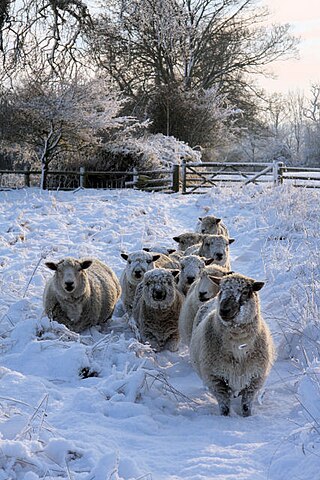
The Ryeland is one of the oldest English sheep breeds going back seven centuries when the monks of Leominster in Herefordshire bred sheep and grazed them on the rye pastures, giving them their name. It was introduced into Australia in 1919 and are classified as an endangered breed by the Rare Breeds Trust of Australia and also are one of the nine heritage breeds that were the foundation of the sheep and wool industry in Australia. The Ryeland was one of the breeds used to introduce the poll gene to the Dorset breed in the development of the Poll Dorset. This breed is raised primarily for meat.

The Lonk is a British breed of domestic sheep. It belongs to the group of black-faced hill breeds of northern England, and is found in the hills of the central and southern Pennines of Lancashire and Yorkshire. It is documented from the mid-eighteenth century; a flock book was started in 1905.

The Oxford Down is a British breed of domestic sheep. It was developed in the 1830s by cross-breeding of Hampshire Down and Southdown ewes with Cotswold rams. It is reared primarily for meat.

The Southdown is a British breed of domestic sheep, the smallest of the British breeds. It is a shortwool breed, and the basis of the whole Down group of breeds. It was originally bred by John Ellman of Glynde, near Lewes in East Sussex, in about 1800. It has been exported to many countries; it has been of particular importance in New Zealand, where it was used in the breeding of Canterbury lamb. In the twenty-first century it is kept principally as a terminal sire.
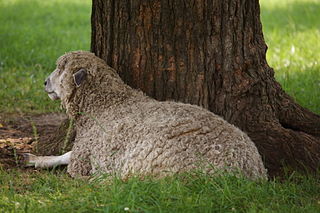
The Leicester Longwool is an English breed of sheep. Alternative names for the breed include: Leicester, Bakewell Leicester, Dishley Leicester, English Leicester, Improved Leicester and New Leicester. It was originally developed by 18th-century breeding innovator Robert Bakewell.
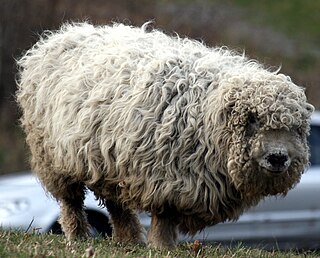
The Greyface Dartmoor is a rare breed of domestic sheep originating around Dartmoor in south west England. Also known as the "Improved Dartmoor", this is a large and long-woolled breed, known for its distinctive facial markings. Its fleece can weigh 7 to 9 kg, and today the breed is primarily raised for meat.

The Dorset Horn is an endangered British breed of domestic sheep. It is documented from the seventeenth century, and is highly prolific, sometimes producing two lambing seasons per year. Among British sheep, it is the only breed capable of breeding throughout the winter.

Alpaca fleece is the natural fiber harvested from an alpaca. There are two different types of alpaca fleece. The most common fleece type comes from a Huacaya. Huacaya fiber grows and looks similar to sheep wool in that the animal looks "fluffy". The second type of alpaca is Suri and makes up less than 10% of the South American alpaca population. Suri fiber is more similar to natural silk and hangs off the body in locks that have a dreadlock appearance. While both fibers can be used in the worsted milling process using light weight yarn or thread, Huacaya fiber can also be used in a woolen process and spun into various weight yarns. It is a soft, durable, luxurious and silky natural fiber.

The Clun Forest is a breed of domestic sheep originating from the area surrounding the Clun Forest in Shropshire, England. Similar to many of the British breeds of upland sheep, Clun Forest are hardy, adaptable, good foragers, and are long–lived. With sleek heads and wide pelvic structures, Clun Forest ewes lamb easily. The breed has a short to medium–length wool and dark brown faces. They are a multi–purpose animal, kept for meat, wool, and milk. Like other dark faced sheep, Clun produce quality lamb and mutton. However, in contrast to more common meat breeds such as Suffolks, their wool is free of undesirable black fibres and kemp, and is suitable for handspinning. The breed's alert and stylish appearance, together with its reputation for hardiness and fecundity have made it popular with hobby farmers and large commercial flock owners alike. The Official Clun Sheep Breeders Society Show & Sale for males and females is held annually in early September at Ludlow livestock market by McCartneys.
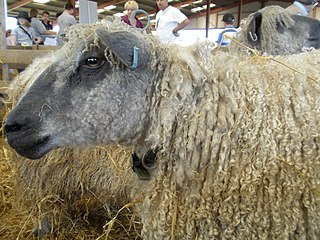
The Wensleydale is a British breed of domestic sheep. It is named for the Wensleydale region of North Yorkshire, in the north of England, where it was bred in the early nineteenth century by cross-breeding a Dishley Leicester ram with local long-woolled sheep of a breed that is now extinct. It has a blue-grey face and long purled wool, and is among the heaviest of British sheep breeds. It is an endangered breed, and is categorised as "at risk" by the Rare Breeds Survival Trust. It is often used as a ram breed to cross with other breeds to obtain market lambs, and for its high-quality wool.
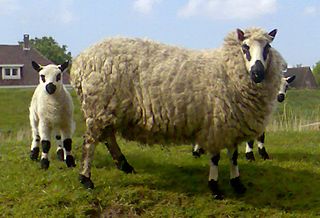
The Kerry Hill is a breed of domestic sheep originating in the county of Powys in Wales. It derives its name from the village of Kerry (Ceri), near Newtown. Kerry Hill sheep have a distinctive and unique coloration, with a white face bearing black markings around the mouth, ears, and eyes. Both rams and ewes are polled. Their wool is white, and their legs are white with black markings. First mentions of the breed date back to the early 19th century, and today it is distributed throughout the United Kingdom, Ireland, the Netherlands, Germany and Denmark. Though still not very numerous, the breed was removed from the records of the Rare Breeds Survival Trust watchlist in 2006. This breed is primarily raised for meat.
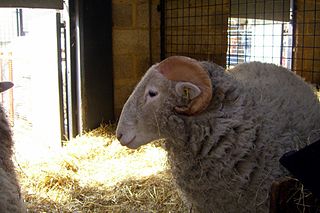
Whitefaced Woodland sheep originated on the Pennine hills around the Woodland Valley, which links Derwent and Ladybower to the Snake Pass and Glossop. It is a combination of two breeds, the Woodland and the Penistone sheep after the Yorkshire town where sheep sales have been held since 1699. It is thought to be closely related to the Swaledale and the Lonk. Substantial commercial flocks of the Whitefaced Woodland are kept in its region of origin, but it is listed as a priority breed by the Rare Breeds Survival Trust

The Boreray, also known as the Boreray Blackface or Hebridean Blackface, is a breed of sheep originating on the St Kilda archipelago off the west coast of Scotland and surviving as a feral animal on one of the islands, Boreray. The breed was once reared for meat and wool, but is now used mainly for conservation grazing. The Boreray is one of the Northern European short-tailed sheep group of breeds.

The Llanwenog is a breed of domestic sheep originating in Wales. It was developed in the 19th century from the Llanllwni, the Shropshire, Welsh Mountain, and Clun Forest breeds. The Llanwenog's native locale is the Teifi Valley, in western Wales, but it has since spread into other areas. The breed association was formed in 1957. Llanwenogs have black faces and medium-length wool. They have a docile temperament and are known for their profligacy in lambing. The breed has a very placid temperament, is easily handled, easily contained and is well suited to stress free inwintering if necessary. This has important consequences for the health of both the animal and its keeper. This breed is raised primarily for meat.
The Devon Closewool is a British breed of domestic sheep. It is distributed almost exclusively on Exmoor in North Devon, in south-west England. It is raised primarily for meat.



















